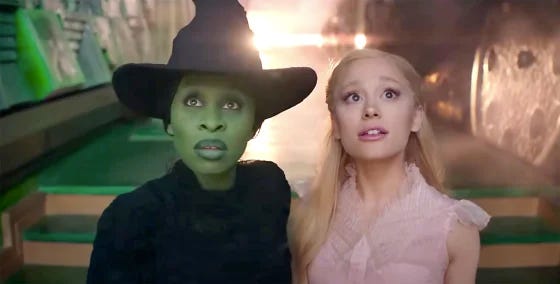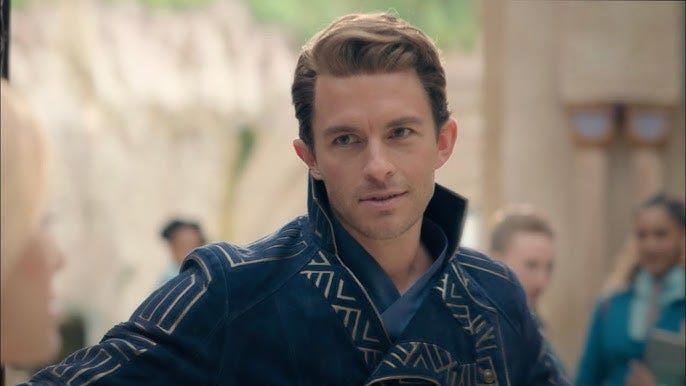“Dancing Through Life” has been my permanent ear worm since I saw Wicked (2024) on Monday night. The song starts as a comic rabble rouser sung by the“empty-headed” Fiyero (Jonathan Bailey). You expect a show-stopper and acrobatics. It delivers in spades.
But it also shows us much that is terrifying and beautiful about 2024. In commanding us to dance, it might hold one key for our resilience. Or at least, for not losing our minds.
Jon M. Chu’s new film Wicked, based on the 2003 Broadway musical that was itself loosely adapted from Gregory Maguire’s 1995 novel, tells us how Oz came to be the way it was “before Dorothy dropped in”—and the story of a fraught friendship between Elphaba (Cynthia “Give Her The Damn Oscar NOW” Erivo) and Galinda (Ariana Grande), a sort of “witch meets witch, witch gets witch, witch loses witch, will witch get witch back?” kind of prequel.
A few hours before I saw Wicked, I taught Dr. Kimerer LaMothe’s article, “What Bodies Know About Religion and the Study of It,” in my first year seminar on sensing religions. LaMothe brings expertise in modern dance to bear on her analysis, asking us to broaden our “scholarly palette” beyond the textual.
By the time I was a graduate student in the early 2000s, scholars were discussing “embodiment,” but we still read bodies like texts— as something to decode through language. “Yet a body is not any object;” LaMothe argues, “bodies are movement by virtue of which all humans … live.” (574)
Wicked, with its endless kinetic parade, gets this. From the dancers to the clocks to the train wheels, everything is in perpetual motion here. And it is in movement that the characters find themselves.
In this first installment (Part II of Wicked drops next year), Elphaba, Galinda, and friends are meant to be young people away at a boarding school called Shiz (aka the Hogwarts of Oz). “Dancing Through Life” starts in the library.
I actually cringed when Fiyero sang the first few lines while walking across the delicate pages of the books, his boots crunching on the paper.
And I think I was supposed to. Like a lot of great speculative fiction, Wicked is also political satire, and “learn to live the unexamined life” has always been a lyric that simultaneously seduces and terrifies. Book burnings have been back in America. Book crushing seemed a bit too much for me in Oz.
But the joy and abandon of Bailey’s performance won me over, and soon enough, I was tapping along as the students cavorted around the library. Only Elphaba, the Hermione of the group, is annoyed by the noise.
It’s not too much of a spoiler to share that the party eventually moves off campus to the Ozdust Ballroom. Elphaba appears for the first time in her pointed black hat, which Galinda has tricked her into wearing. It quickly turns into a nightmare for her, like the worst middle school dance ever in a setting strangely evocative of Back to the Future’s “Enchantment Under the Sea” set.
Here, though—here is where the dancing takes over, and where the film takes us to a realm that the stage production couldn’t quite reach.
This is the moment where Elphaba— a highly verbal person who has a canned speech ready to explain her greenness to everyone she meets, and magic for when things go really wrong— here Elphabas goes and does the scary, vulnerable thing.
She dances.
Alone.
Even though everyone is watching.
It’s so painful, and so beautiful, and so painful. And when Galinda comes face to face, to join her, it is still painful, because her movements hold so much shame and contrition.
I saw Wicked twice on Broadway. Once with the original cast, when I was a graduate student, from the rear of the orchestra. Once with my husband and daughter, from the top of the mezzanine, my glasses fogged from my face mask. Both times, this scene played out almost like a pantomime for me. I saw the big gestures meant for me, at the back of the house. Powerful, but distant. The result from where I saw was, yes, said, poignant, pathetic, in the original sense of pathos, but also comic. It was hard to relate.
Yet on the screen, the close-ups brought me straight into the vulnerability of the performance. Every twist of the wrist; every tear and grimace. I was deeply uncomfortable in the way good film is supposed to unsettle you. I was also in tears.
This movie doesn’t just pass the Bechdel test, I thought. It blows up the whole thing. We need a whole new scale.
Wicked was a landmark in musical theatre history for similar reasons. In Changed for Good: A Feminist History of the Broadway Musical, Professor Stacy Wolf argues that the show’s musical structure constructs the two women as a queer couple (while “the spoken text tells the political story of an ethically responsible, individual girl who becomes a scapegoat”). Yes, the story’s official love triangle revolves around the women and Fiyero. But that’s not the relationship that really matters. The women are where it’s at.
But why did I promise you so much at the top of this newsletter? Why dancing? In case you haven’t noticed, there are a few wars, natural disasters, and instances of political drama in the news laltely. Wicked is still “just” a movie.
For one thing, dancing (and film, and musicals) matter because genre matters. What does it mean to watch two women dance a dance of contrition and consolation a few weeks after unapologetic racism took center stage at Madison Square garden? What does it mean to watch a Black woman, cast as Elphaba, embody so much power onscreen, just a few weeks after Americans voted against a Black, South Asian American woman at the ballot box? *
Here, I’ll return to Wolf. She argues that “gender and genre are inseparable”— as women’s roles in musicals changed, they irrevocably changed the form (19). I fear that in the reception of the movie, many people will miss what I see in it, and what she described regarding the show:
“Many critics preoccupation with spectacle and marketing causes them to miss that the political punch of this musical regards what happens on stage in regards to musical theatre’s formal conventions: two women form a primary relationship and dance together. In other words, the progressive power of the piece is less in the overtly stated politics of the show about government and leadership, and more in the representation and performative power of a pair of women on stage together.” (217)
She wrote that about fourteen years ago.
I’m not naive enough to think that the genre of politics is suddenly changing, either in the United States or elsewhere. And I’m not saying that art is going to save us, at least not in a simplistic way. Art is not going to reduce carbon emissions or provide safe health care for all.
But I will take movie musical magic, any day, every day, over hateful rallies. It’s the air I know how to breathe. It’s the air a lot of us breathe. And yes, while I am committed to live theatre and regional theatre: A ticket to Wicked on Broadway typically costs over a hundred dollars. A ticket to Wicked at the movies costs about one tenth of that price. Movie musicals can be a big tent.
In suggesting that dancing through life is the way forward, I don’t mean to suggest it blithely. I am thinking about the “golden” ages of Hollywood and Broadway, which had depression, hot wars, and Cold Wars as their historical backdrops. The Wizard of Oz -the original film with Judy Garland—premiered in August, 1939. It was a few months after the 1939 Nazi rally at Madison Square Garden. It was a few weeks before Hitler invaded Poland. Everyone looks back at “Somewhere Over the Rainbow” with nostalgia. How often do we think about just how bad things were in Kansas at that moment?
Why dance? We need to dance sometimes because bodies know things in different ways. LaMothe writes about religion as “a rhythm of bodily becoming” (583). “As we move, we also bring into being the network of relationships with persons, places, and powers of the universe that support us in making those movements and becoming the (dancing)** persons we have the potential to be.” In the vulnerable dancing bodies of Wicked, I saw glimmerings of hope. I was at the edge of my seat. I wanted to get up and dance, too.
Embodiment isn’t all good. Back in graduate school, back when I first heard Idina Menzel belt out “Defying Gravity,” I also read books like Elaine Scarry’s The Body in Pain. Senses go beyond language in ways that are both sublime and subduing, silencing. We have to consider the ethics of our bodies’ borders. Something in shorter and shorter supply.
Let’s not look to dance, or to Wicked, as a panacea. There is none, because there is no man behind the curtain who can take whisk us all to safety.
“Dancing through life, down at the Ozdust—only because dust is what we come to” Fiyero croons. The pretty boy smashes books, but he’s been reading Genesis 3. You were taken out of the earth—from dust, you, to dust you return. (כִּֽי־עָפָ֣ר אַ֔תָּה וְאֶל־עָפָ֖ר תָּשֽׁוּב)
That’s why he knows all too well that we need to dance.
*No, I’m not trying to suggest this is the only reason the Democrats lost the election. There is no one reason. That post-mortem is well beyond the scope of this blog. But this loss is a cultural thing that has happened, with emotional and representational fallout for a lot of people. The door to the oval office remains closed to women, and women of color continue to face countless double binds.
**For those concerned about ableism and dancing, literally and metaphorical: I think about this a lot too, anytime I suggest a somatic solution without considering the vast diversity of our bodies. Work is happening here too. Rabbi Dr. Julia Watts Belser is one person who has written on disability dancing from a Jewish ethical and hermeneutic perspective.
Lest you think there is no Disney content this week: It’s true, WICKED (2024) is a Universal picture. (If Universal studios _doesn’t_ find a way to build Oz at one of their theme parks, well, they’re missing out on a boatload of cash). However, once upon a time, Disney’s Hollywood Studios theme park in Orlando was known as Disney’s MGM Studios. Its marquee opening day attraction, The Great Movie Ride (RIP), featured a gorgeous scene from the Wizard of Oz. One year I wore my tee shirt with an image of the ruby slippers from the US Smithsonian to the park so I would be on theme that day.





